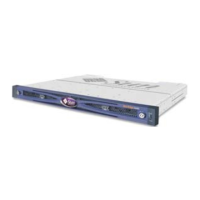6-1
CHAPTER
6
First-Time Configuration
This chapter summarizes the most common procedures used for first-time
configuration.
This chapter covers the following topics:
■ “Initial Configuration Steps” on page 6-2
■ “Viewing the Initial Firmware Window” on page 6-2
■ “Checking Available Physical Drives” on page 6-4
■ “Configuring FC Channels as a Host or Drive Channel (Optional)” on page 6-5
■ “Choosing Loop or Point-to-Point Fibre Connection” on page 6-7
■ “Editing and Creating Additional Host IDs (Optional)” on page 6-8
■ “Selecting Sequential or Random Optimization” on page 6-11
■ “Maximum Number of Disks and Maximum Usable Capacity for Random and
Sequential Optimization” on page 6-12
■ “Reviewing Default Logical Drives and RAID Levels” on page 6-14
■ “Completing Basic Configuration” on page 6-16
■ “Preparing for Logical Drives Larger Than 253 Gbyte” on page 6-17
■ “Deleting Logical Drives” on page 6-19
■ “Creating Logical Drives” on page 6-21
■ “Changing a Logical Drive Controller Assignment (Optional)” on page 6-28
■ “Creating or Changing a Logical Drive Name (Optional)” on page 6-30
■ “Partitioning a Logical Drive (Optional)” on page 6-31
■ “Mapping Logical Drive Partitions to Host LUNs” on page 6-35
■ “Planning for 1024 LUNs (Optional, Loop Mode Only)” on page 6-37
■ “Using the Map Host LUN Option” on page 6-37
■ “Setting Up Host Filter Entries” on page 6-42
■ “Creating Device Files for the Solaris Operating Environment” on page 6-51
■ “Saving Configuration (NVRAM) to a Disk” on page 6-52
■ “Using Software to Monitor and Manage the Sun StorEdge Fibre Channel Array”
on page 6-53
■ “Other Supported Software” on page 6-54
■ “Enabling VERITAS DMP” on page 6-54
■ “The VERITAS Volume Manager ASL” on page 6-55

